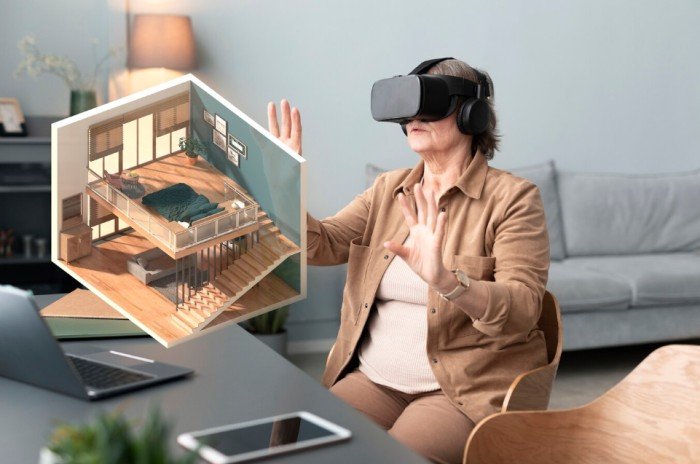Virtual Reality (VR) is changing architecture. Its popularity is so widespread that nine out of 20 major architectural firms worldwide use it for their design processes.
Imagine putting on a headset that isolates you from the real world, immersing you in an alternate environment that’s 100% designed by humans. Guided by the way you move your head, you can look up, down, and around as you explore every square inch of your simulated environment.
It’s the ultimate experience and an unparalleled upgrade to traditional marketing tools.
If you’re a professional in real estate, now may be the time to tap into the architectural benefits of VR.
What Is VR in Architecture?
Einstein famously said, “Imagination is more important than knowledge.”
Over the past few years, companies have increasingly been turning to technologies to transform their designs, turning their visions into virtual worlds that are waiting to be experienced.
Virtual Reality (VR) is an important piece of that puzzle. VR facilitates a firsthand exploration of the space. Its users can even interact with interior elements like closing and opening doors, viewing it from different angles, and zooming in and out to get a better look at a listing’s different features.
It provides a more immersive experience so stakeholders can have a more complete and accurate idea of the actual design. By showing how the space would look upon being built—from floor plans to layout, texture, materials, and other details—it inspires an emotional connection with clients. Instead of poring over technical and sometimes uninspiring 2D blueprints and sketches, they can actively explore carefully designed spaces for themselves.
VR Vs 3D Walkthroughs
Is virtual reality the same as 3D walkthroughs? There are a lot of similarities between virtual reality and 3D walkthroughs, mostly because they both use 3D graphics.
However, VR generally requires the viewer to wear a headset. Some of the most popular VR headsets nowadays are the Oculus, Playstation VR, Valve Index, and HTC Vive. Because these headsets wrap around the user’s head, the external environment is blocked out, allowing the simulated world to take center stage.
VR headsets can cost anywhere from a few hundred to well over a thousand dollars. If you’re planning to offer VR tours for the public, you’ll need to consider commercial-grade headsets that are more expensive. You should also think about creating a safe area where users can safely explore virtual environments.
Since 3D walkthroughs don’t require special equipment, they’re easier and cheaper to implement for mass viewing. They can also be more easily shared because all the viewer needs is a smartphone or a laptop with a decent graphics card.
However, VR is still unique because of the unique firsthand experiences it affords viewers.
How Is VR Used in Architecture and Construction?
VR can do so much more than granting the ability to create and experience simulated environments.
Since it can be done at different stages of property development, you can control the cost and elements by working with an architectural 3D design firm. Maybe you want to:
- Highlight certain aspects like the floor plan
- Add mood lighting, shadows, and interior features
- Combine it with augmented reality (AR) and building information modeling (BIM) to create maximum impact
- Leverage V-commerce to give clients customization options
- Inspire prospective clients and tenants on how they can use the space
Virtual reality in architecture and construction allows you to sell better. The client can be better engaged by optimizing the relationship between every element. It also provides greater opportunities for receiving more input. Clients can personalize the space more viscerally.
By doing so, VR can help build client loyalty, making them much more likely to invest.
How Can Virtual Reality Complement Your Project?
Here’s how to use VR in architecture to increase engagement, sales, and customers.
Easy Accessibility
Technological advancements have altered our everyday routines for the better which is the case for VR in architecture, design, and construction.
With VR in your arsenal, you can entertain clients from anywhere even if they’re halfway around the world from you (as long as they have appropriate headsets of course). Wherever your potential clients are, they can watch immersive, 360-degree virtual reality videos.
You can even use the technology for people with disabilities to enhance the accessibility of your designs. According to a 2020 publication, immersive virtual reality (IVR) technology can improve the architect’s understanding of the needs of different users, particularly those who are elderly and differently-abled.
It can help professionals cultivate an inclusive environment where everyone can interact with the space without technical jargon that is difficult to understand.
Better User Experience
Pitching a design can be challenging. To tempt and persuade stakeholders to work with you, they have to appreciate what your design brings to the table.
In many instances, two-dimensional sketches are insufficient as they lack depth. They’re severely limiting which explains why more and more real estate professionals are turning to VR, AR, and other types of 3D walkthroughs.
Virtual reality gives clients a memorable experience of a structure. It allows clients to understand the design, appreciate its winning features and details, and gain accurate insights into its layout, structure, materials, and more.
A 2017 study reinforced these benefits by demonstrating that immersive VR environments allowed users to recognize features more accurately than traditional methods. No wonder 40% of professionals in Europe rely on it!
In addition to using VR for design presentations, the technology can also be used for architectural niches like the preservation of cultural heritage sites. It can be employed during various conservation-related activities such as visualization, restoration, public engagement, and education.
Better Opportunities To Receive and Incorporate Feedback
By giving you a bird’s eye view into the elements that make a house a home or a commercial building the go-to spot for residents in town, VR allows you to make changes to the design in its early stages of development and construction.
This is beneficial for the client and architect.
For the client, it means getting a feel for the project before they’ve put any money down, thereby limiting their liability in a market with short-term fluctuations. Plus, they can ask for revisions to create a more favorable environment that meets their needs and preferences.
For the architect, it means enormous time and cost-saving benefits. By incorporating the feedback the client asked for, architects can consider the impact it will have on the form and functionality of the space. This input can ensure that the result meets the client’s expectations. Architects can also cut down on project execution costs, avoiding costly damage control processes in the construction stage by improving the accuracy of the design.
Safer Designs
Virtual reality is a crucial tool for getting the client’s approval on a new and innovative design. However, since you’re exploring an unknown territory, it can be a risky venture.
This risk can be minimized through VR. Virtual reality can help designers and builders create safer construction sites. It calls for collaboration with construction professionals who can describe and help address work hazards that are involved in building the project.
Aids the Design of Sustainability Features
According to a 2016 study, virtual reality can predict the energy performance of buildings and analyze user behavior to forecast energy consumption. Though there will be a discrepancy between the two (called a performance gap), it can still be a helpful tool for architects and builders who are looking to include sustainability features in their projects.
Seamless Collaboration
Virtual reality is not bound by physical barriers. It does not require you to be present at a specific location. So, everyone from the architect to the interior designer can collaborate on perfecting a design from any corner of the world. As such, rendering companies are no longer restricted to hiring team members from their location. They can seek the best talent regardless of location.
They can use communication tools and 3D assets to ensure that everyone’s on the same page which can be done in real time! Since nothing is left to interpretation, it streamlines the collaboration process, making it easier to meet and exceed client preferences and expectations.
Which Real Estate Projects Can Benefit From VR?
VR is more complicated to implement than other visualization solutions so you shouldn’t feel compelled to use it for every project, especially minor ones that are simple and quick to build.
However, it may be warranted for real estate developments that:
- Are complex and lengthy to build
- Require multiple approvals from various stakeholders
- Are large-scale, expensive, and will be marketed to people from different geographical regions
- Are high-profile and closely monitored by the public
- Have several, complex features that may be difficult for ordinary people to appreciate
- Are undergoing an aggressive preselling stage before they’re built
In such instances, VR is an excellent tool for helping explain selling features while managing expectations.
Unlock the Future of Architecture, Design, and Construction With Plus Render
Plus Render uses innovative technologies like virtual reality in urban design to create better prototypes that can communicate your vision while giving you more control over the proposed model!
Sixty-seven percent of large firms are using it to create a personalized experience that can boost their bottom line. It may be time for you to consider upgrading your operations with VR presentations. Book a call today to learn how we can help.







